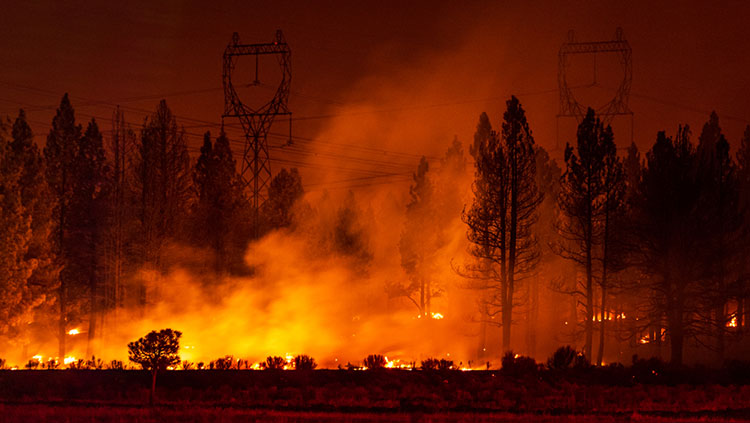Wildfire Smoke Altered Brain Structures Related to Memory in Mice
- Published30 Jan 2024
- Author Christine Won
- Source BrainFacts/SfN

This past year, wildfires swept across North America from Quebec to Hawaii, sending millions seeking shelter and cleaner air inside their homes. Amid climate change, its impact on the brain is an increasingly important question as extreme weather disasters become more prevalent, widespread, and catastrophic.
Preliminary research presented at Neuroscience 2023 in Washington, D.C., the Society for Neuroscience’s annual meeting, reveals inhaling fine particulate matter from wildfire smoke altered key areas of mouse brain structure related to memory, aging, and neurodegenerative disease — and the effect was more pronounced in older mice. These findings bring into question what the future holds for people aging on a rapidly warming planet.
As wildfires become more common, more people will be exposed to the noxious stew of compounds emitted from wildfire smoke. Most concerning are tiny particles designated PM2.5. Fewer than 2.5 micrometers in diameter, PM2.5 particles are 30 times smaller than the width of the average human hair. While our lungs can trap large, inhaled particles, PM2.5 particles slip through the lungs and into the bloodstream. PM2.5 exposure can exacerbate pulmonary and cardiovascular issues like aggravated asthma and irregular heartbeat.
Previous research has long suggested breathing polluted air may damage the brain, but researchers say not many have focused on wildfire smoke.
"It's a relatively under-investigated chunk of research in this area, so I'm excited to see the results," says Kimberly Doell of the University of Vienna, first author on a commentary about leveraging neuroscience in the climate crisis published November 13 in Nature.
Now, the preprint study funded by the National Institutes on Aging shows wildfire smoke inhalation may raise the likelihood of neurodegenerative disease in mice, with older mice being more susceptible to this risk.
Andrew Ottens of Virginia Commonwealth University and colleagues at the University of New Mexico exposed mice to wildfire smoke drifting into New Mexico from California. The researchers examined mice hippocampal tissue via mass spectrometry, a data analysis tool, to perform an unbiased characterization of the molecules in the tissue.

After three weeks of exposure in a mobile lab, the animals’ hippocampus (a key area involved in memory and learning) showed neurodegenerative markers that are typical hallmarks of Alzheimer’s disease and related dementias. Specifically, wildfire smoke exposure altered 30% of proteins in the mouse hippocampus, of which 20% were associated with neurodegeneration — such as an increase of amyloid protein and reduced polymerized tau protein. The alteration of these proteins, both key markers linked to Alzheimer’s, were more prominent in older smoke-exposed mice.
“We were surprised as to how significantly the data correlated with neurogenerative disease,” says Ottens, the study’s senior author. “I’ve been using these approaches in brain studies for over two decades, and I’ve never seen an exposure that was so heavily weighted to an association with neurodegenerative disease. That surprised me. It was consistent with what we were testing, but it was shockingly evident.”
Ottens stressed it's important to note the study was unbiased — rather than examining specific markers, they looked at all the changes occurring in the hippocampal tissue. They found the most prominent alterations were the neurodegenerative markers. "In doing so, we can be more confident that we have a better understanding as to the most evident response inside the hippocampus consequent wildfire smoke exposure.”
An October 11 review of the role of wildfire smoke and air quality on aging and longevity published in Frontiers in Toxicology noted the Ottens study, which did not directly conclude these fine particles are crossing the blood-brain barrier, provides strong evidence these fragments are reaching the brain.
David Scieszka of the University of New Mexico Health Sciences Center, the first author on the review who was not involved in the study, emphasized the importance of further research into the environmental impact on general aging. "It's a burgeoning field right now to examine the interplay between environmental toxicology and aging,” he says, adding a call to action for people to take interest and get involved in ways to mitigate the effects of climate change. “I do believe we're going to see an unprecedented level of environmental disasters that we haven't seen before.”
CONTENT PROVIDED BY
BrainFacts/SfN



















